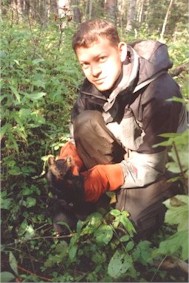
Neil Darlow
Movement behaviour of dispersing tree squirrels in fragmented habitats
 |
Neil Darlow Movement behaviour of dispersing tree squirrels in fragmented habitats |
Habitat fragmentation is a pervasive problem that is assumed to impede the movement of individuals between habitat patches reducing dispersal, gene flow, and colonization probabilities. However little is known about how animals move between patches and which elements of matrix habitat either promote or impede animal movement.
Objective 1: Working in highly fragmented agricultural landscapes I am looking at how forest dependent species, North American red squirrels (Tamiasciurus hudsonicus) and Northern flying squirrels (Glaucomys sabrinus), select movement pathways during natal dispersal and aim to determine the costs and benefits involved. Such an approach should help in determining which elements of matrix habitat provide connectivity and will add to our understanding of the proximate mechanisms involved in dispersal.
Objective 2: Mammal movement in fragmented habitats is often studied by translocating individuals outside of their home range and observing how these individuals respond to the intervening habitat elements on their homing path. Using this information to reveal how individuals disperse in fragmented habitats relies on several untested assumptions. My second aim is to compare dispersal movements to these translocation movements to test whether this method is appropriate and sufficient for studying animal movement in fragmented habitats.